TimTaiLieu.vn - Tài liệu, ebook, giáo trình, đồ án, luận văn
TimTaiLieu.vn - Thư viện tài liệu, ebook, đồ án, luận văn, tiểu luận, giáo trình các lĩnh vực CNTT, Ngoại ngữ, Luật, Kinh doanh, Tài chính, Khoa học...

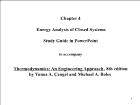 Bài giảng Thermodynamics: An Engineering Approach, 8th edition - Chapter 4: Energy Analysis of Closed Systems
Bài giảng Thermodynamics: An Engineering Approach, 8th edition - Chapter 4: Energy Analysis of Closed SystemsThe first law of thermodynamics is an expression of the conservation of energy principle. Energy can cross the boundaries of a closed system in the form of heat or work. Energy transfer across a system boundary due solely to the temperature difference between a system and its surroundings is called heat. Work energy can be thought of as the energ...
 67 trang | Chia sẻ: nguyenlinh90 | Ngày: 25/07/2019 | Lượt xem: 947 | Lượt tải: 0
67 trang | Chia sẻ: nguyenlinh90 | Ngày: 25/07/2019 | Lượt xem: 947 | Lượt tải: 0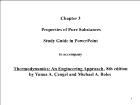 Bài giảng Thermodynamics: An Engineering Approach, 8th edition - Chapter 3: Properties of Pure Substances
Bài giảng Thermodynamics: An Engineering Approach, 8th edition - Chapter 3: Properties of Pure SubstancesWe now turn our attention to the concept of pure substances and the presentation of their data. Simple System A simple system is one in which the effects of motion, viscosity, fluid shear, capillarity, anisotropic stress, and external force fields are absent. Homogeneous Substance A substance that has uniform thermodynamic properties throughout...
 61 trang | Chia sẻ: nguyenlinh90 | Ngày: 25/07/2019 | Lượt xem: 853 | Lượt tải: 0
61 trang | Chia sẻ: nguyenlinh90 | Ngày: 25/07/2019 | Lượt xem: 853 | Lượt tải: 0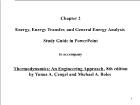 Bài giảng Thermodynamics: An Engineering Approach, 8th edition - Chapter 2: Energy, Energy Transfer, and General Energy Analysis
Bài giảng Thermodynamics: An Engineering Approach, 8th edition - Chapter 2: Energy, Energy Transfer, and General Energy AnalysisWe will soon learn how to apply the first law of thermodynamics as the expression of the conservation of energy principle. But, first we study the ways in which energy may be transported across the boundary of a general thermodynamic system. For closed systems (fixed mass systems) energy can cross the boundaries of a closed system only in the form ...
 48 trang | Chia sẻ: nguyenlinh90 | Ngày: 25/07/2019 | Lượt xem: 1015 | Lượt tải: 0
48 trang | Chia sẻ: nguyenlinh90 | Ngày: 25/07/2019 | Lượt xem: 1015 | Lượt tải: 0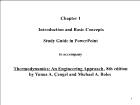 Bài giảng Thermodynamics: An Engineering Approach, 8th edition - Chapter 1: Introduction and Basic Concepts
Bài giảng Thermodynamics: An Engineering Approach, 8th edition - Chapter 1: Introduction and Basic ConceptsINTRODUCTION The study of thermodynamics is concerned with the ways energy is stored within a body and how energy transformations, which involve heat and work, may take place. One of the most fundamental laws of nature is the conservation of energy principle. It simply states that during an energy interaction, energy can change from one form to an...
 34 trang | Chia sẻ: nguyenlinh90 | Ngày: 25/07/2019 | Lượt xem: 1029 | Lượt tải: 0
34 trang | Chia sẻ: nguyenlinh90 | Ngày: 25/07/2019 | Lượt xem: 1029 | Lượt tải: 0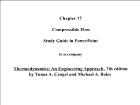 Bài giảng Thermodynamics: An Engineering Approach - Chapter 17: Compressible Flow
Bài giảng Thermodynamics: An Engineering Approach - Chapter 17: Compressible FlowStagnation Properties Consider a fluid flowing into a diffuser at a velocity , temperature T, pressure P, and enthalpy h, etc. Here the ordinary properties T, P, h, etc. are called the static properties; that is, they are measured relative to the flow at the flow velocity. The diffuser is sufficiently long and the exit area is sufficiently large t...
 58 trang | Chia sẻ: nguyenlinh90 | Ngày: 25/07/2019 | Lượt xem: 873 | Lượt tải: 0
58 trang | Chia sẻ: nguyenlinh90 | Ngày: 25/07/2019 | Lượt xem: 873 | Lượt tải: 0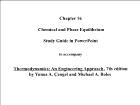 Bài giảng Thermodynamics: An Engineering Approach - Chapter 16: Chemical and Phase Equilibrium
Bài giảng Thermodynamics: An Engineering Approach - Chapter 16: Chemical and Phase EquilibriumSince the percent theoretical air is known, the N2 balance gives B. The H balance gives G. Then the C and O balances give two equations that relate the remaining three unknowns D, E, and F. Therefore, we need one more equation. To obtain this last equation relating the mole numbers of the products, we assume that the products are in chemical equil...
 32 trang | Chia sẻ: nguyenlinh90 | Ngày: 25/07/2019 | Lượt xem: 981 | Lượt tải: 0
32 trang | Chia sẻ: nguyenlinh90 | Ngày: 25/07/2019 | Lượt xem: 981 | Lượt tải: 0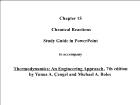 Bài giảng Thermodynamics: An Engineering Approach - Chapter 15: Chemical Reactions
Bài giảng Thermodynamics: An Engineering Approach - Chapter 15: Chemical ReactionsInitially, we shall consider only those reactions that go to completion. The components prior to the reaction are called reactants and the components after the reaction are called products. For more information and animations illustrating this topic visit the Animation Library developed by Professor S. Bhattacharjee, San Diego State University, at...
 49 trang | Chia sẻ: nguyenlinh90 | Ngày: 25/07/2019 | Lượt xem: 962 | Lượt tải: 0
49 trang | Chia sẻ: nguyenlinh90 | Ngày: 25/07/2019 | Lượt xem: 962 | Lượt tải: 0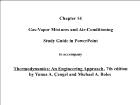 Bài giảng Thermodynamics: An Engineering Approach - Chapter 14: Gas-Vapor Mixtures and Air-Conditioning
Bài giảng Thermodynamics: An Engineering Approach - Chapter 14: Gas-Vapor Mixtures and Air-ConditioningWe will be concerned with the mixture of dry air and water vapor. This mixture is often called atmospheric air. The temperature of the atmospheric air in air-conditioning applications ranges from about –10 to about 50oC. Under these conditions, we treat air as an ideal gas with constant specific heats. Taking Cpa = 1.005 kJ/kgK, the enthalpy of ...
 38 trang | Chia sẻ: nguyenlinh90 | Ngày: 25/07/2019 | Lượt xem: 1102 | Lượt tải: 0
38 trang | Chia sẻ: nguyenlinh90 | Ngày: 25/07/2019 | Lượt xem: 1102 | Lượt tải: 0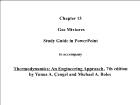 Bài giảng Thermodynamics: An Engineering Approach - Chapter 13: Gas Mixtures
Bài giảng Thermodynamics: An Engineering Approach - Chapter 13: Gas MixturesThe discussions in this chapter are restricted to nonreactive ideal-gas mixtures. Those interested in real-gas mixtures are encouraged to study carefully the material presented in Chapter 12. Many thermodynamic applications involve mixtures of ideal gases. That is, each of the gases in the mixture individually behaves as an ideal gas. In this sect...
 22 trang | Chia sẻ: nguyenlinh90 | Ngày: 25/07/2019 | Lượt xem: 871 | Lượt tải: 0
22 trang | Chia sẻ: nguyenlinh90 | Ngày: 25/07/2019 | Lượt xem: 871 | Lượt tải: 0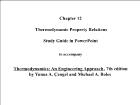 Bài giảng Thermodynamics: An Engineering Approach - Chapter 12: Thermodynamic Property Relations
Bài giảng Thermodynamics: An Engineering Approach - Chapter 12: Thermodynamic Property RelationsSome thermodynamic properties can be measured directly, but many others cannot. Therefore, it is necessary to develop some relations between these two groups so that the properties that cannot be measured directly can be evaluated. The derivations are based on the fact that properties are point functions, and the state of a simple, compressible sys...
 38 trang | Chia sẻ: nguyenlinh90 | Ngày: 25/07/2019 | Lượt xem: 853 | Lượt tải: 0
38 trang | Chia sẻ: nguyenlinh90 | Ngày: 25/07/2019 | Lượt xem: 853 | Lượt tải: 0
Website đang trong thời gian thử nghiệm, chờ xin giấy phép của Bộ TT & TT.

